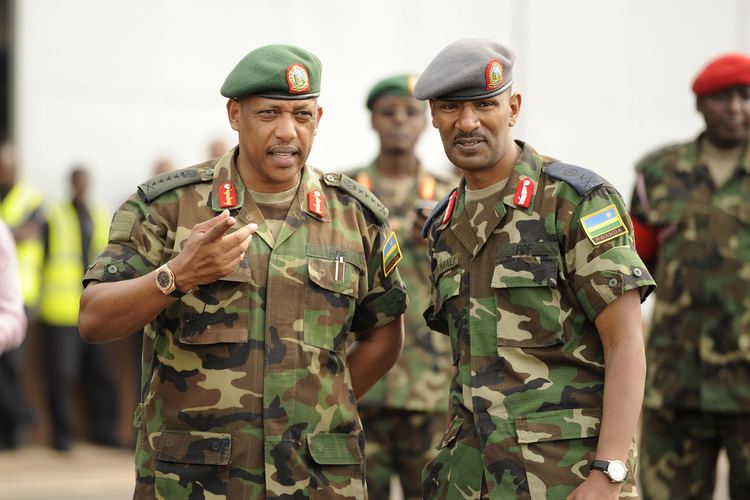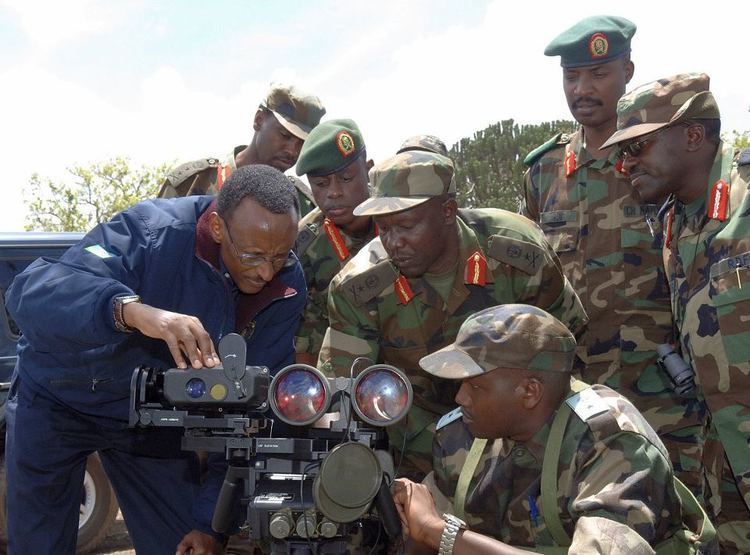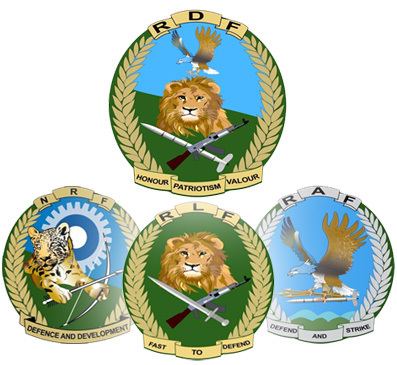Current form 1994 Founded 1962 | ||
 | ||
Service branches Army, Air Force, Reserve Force Available formilitary service 2,625,917 males, age 16–49 (2010 est.),2,608,110 females, age 16–49 (2010 est.) Similar Armed Forces of the Demo, Uganda People's Defence, Combined Joint Task Force – H, Tanzania People's Defence, Zambian Defence Force | ||
The Rwanda Defence Force (RDF) (in Kinyarwanda: Ingabo z'u Rwanda) is the national army of Rwanda. The country's armed forces were originally known as the Rwandan Armed Forces (FAR), but following the victory of the Rwandan Patriotic Front in the country's civil war in 1994, it was renamed to the Rwandan Patriotic Army (RPA), and later to its current name.
Contents

The RDF comprises:

In November 2002 Emmanuel Habyarimana was removed from his post as Minister of Defence, an action which government spokesperson Joseph Bideri attributed to his "extreme pro-Hutu" views. Marcel Gatsinzi became Minister of Defence (in office 2002-2010) in succession to Habyarimana.

After it conquered the country in July 1994 in the aftermath of the Rwandan genocide of April to July 1994, the Rwandan Patriotic Front (RPF) decided to split into a political division (which retained the RPF name) and a military division, which would serve as the official army of the Rwandan state.

Defence spending continues to represent an important share of the national budget, largely due to continuing security problems along Rwanda's frontiers with the Democratic Republic of the Congo and Burundi, and lingering concerns about Uganda's intentions towards its former ally. The Rwandan government launched an ambitious plan to demobilize thousands of soldiers, resulting in a standing military of 33,000 and another 2,000-strong paramilitary force - a decrease from 70,000 in just a decade.
During the First and Second Congo Wars of 1996-2003, the RPF committed wide-scale human-rights violations and crimes against humanity in the Democratic Republic of the Congo, according to the United Nations Mapping Report.
Historical outline 1962–1994
The U.S. Army's Area Handbook for Rwanda, compiled in 1968-9, describes the security forces of Rwanda in 1969 as the 2,500 strong National Guard and the National Police, about 1,200 strong. The National Guard had been established two years before independence and had gained experience by repelling small Tutsi invasions in 1963 and 1964. It was under the direction of the Minister of Defence, Juvénal Habyarimana, who also held the function of Chief of Staff of the National Guard in mid-1969. At that time it was composed of a headquarters, an intervention group (effectively an infantry battalion), five other rifle companies, and five independent rifle platoons.
The Forces armées rwandaises (FAR) was the national army of Rwanda until July 1994, when the government collapsed in the aftermath of the Genocide against Tutsi and the war with the Rwandan Patriotic Front. The FAR was estimated at 7,000 strong, including approximately 1,200 members of the Gendarmerie. Elite troops included the Presidential Guard, estimated at between 1,000-1,300 troops, as well as the Paracommando and Reconnaissance units. These two units were of battalion strength by 1994, and then counted a total of 800 troops.
In response to the RPF invasion of 1990, the 5,000-man FAR rapidly expanded, with French training assistance (as many as 1,100 French troops were in Rwanda at a time), to some 30,000 by 1992.
The Arusha Accords, signed on August 4, 1993, laid out a detailed plan for the integration of the Rwandan Government and Rwandan Patriotic Front military forces. The Rwandan government was to provide 60% of the troops for the new integrated army, but would have to share command positions with the RPF down to the level of battalion. The new army was to consist of no more than 19,000 soldiers and 6,000 Gendarmerie. However radical elements within the Rwandan government were implacably opposed to implementation of the Accords and, instead, began the planning that would lay the foundations for the genocide.
The Reconnaissance Battalion's commander, François-Xavier Nzuwonemeye, and his subordinates played a key role during the genocide. Together with the Reconnaissance Battalion, the Paracommando Battalion under Major Aloys Ntabakuze and the Presidential Guard under Major Protais Mpiranya became the three most significant genocidare units.
Col. Marcel Gatsinzi was briefly named chief of staff of the armed forces from April 6 to April 16, 1994, but was replaced by Augustin Bizimungu, who was quickly promoted to major general, since Col. Gatsinzi opposed the genocide. Bizimungu was only briefly chief of staff before fleeing the country. Many soldiers of the FAR have since been implicated by the International Criminal Tribunal for Rwanda in the genocide, including its leader during the genocide, Col. Théoneste Bagosora, who was chief of the cabinet (private office) of the Ministry of Defence prior to the genocide. Other top leaders in the FAR were implicated in the assassination of the Rwandan president, Juvénal Habyarimana, which sparked the genocide.
Many elements of the former Rwandan regime, including soldiers of the FAR, fled to eastern Zaire after the RPF victory, where they formed the Rassemblement Démocratique pour le Rwanda (RDR), which later became the Democratic Forces for the Liberation of Rwanda (FDLR), which is still active in eastern Congo's North Kivu Province.
Land Forces
A number of sources, including Gérard Prunier, document U.S. aid to the RPA before the First Congo War. The officially admitted part of the training was Joint Combined Exchange Training. Prunier strongly implies the United States supplied communications equipment, vehicles, boots, and medicines to the RPA before the war began and after it broke out, delivered second-hand Warsaw Pact weapons and ammunition either directly to Goma or by airdrop along the AFDL front lines. He reports that after the war's outbreak, the U.S. Air Force had switched from using C-141 Starlifters and C-5 Galaxys to deliver the non-lethal aid to Kigali Airport and Entebbe Airport, to airdrops by C-130 Hercules aircraft.
From July 1994 until December 1997 the RPA had six brigades, as designated in the Arusha Accords: 402nd in Kigali and Kigali Rurale Prefecture; 201st in Kibungo, Umatura, and Byumba Prefectures; 301st in Butare, Gikongoro, and Cyangugu Prefectures; 305th in Gitatama and Kibuye Prefectures; and 211th in Gisenyi and Ruhengeri Prefectures. The brigade boundaries mirrored the political administrative boundaries, which often complicated military operations. During the First Congo War the brigade headquarters remained inside Rwanda but directed operations inside the Democratic Republic of the Congo.
Jane's World Armies said in July 2009 that 'the RDF is deployed to protect the country's borders and defend against external aggression. There are four divisions, each deploying three brigades:
The Cyangugu Military Camp has been reported to house the 31st Brigade of the 4th Division.
Gen. Patrick Nyamvumba has been Chief of Defence Staff since June 2013.
Many soldiers from the former Rwandan Armed Forces (FAR), the national army under the previous regime, have been incorporated into the RDF since 1994. This process began soon after the genocide in January 1995, when several former FAR officers were given senior positions in the new armed forces: Col. (later Gen.) Marcel Gatsinzi became the Deputy Chief of Staff of the RPA, Col. Balthazar Ndengeyinka became commander of the 305th Brigade, Lt. Col. Laurent Munyakazi took command of the 99th Battalion, and Lt. Col. (later Brig. Gen.) Emmanuel Habyarimana became an RPA Member of Parliament and Director of Training in the Ministry of Defence. Gen. Gatsinzi later became Director of Security and then Minister of Defence in 2002.
Circa 2000 during the Second Congo War, the Rwanda Patriotic Army unofficially admitted to having 4,000 to 8,000 troops deployed in the Congo, according to the Economist Intelligence Unit, but this was believed to be a substantial understatement. The International Crisis Group estimated that the RPA has between 17,000 and 25,000 troops deployed in the Congo. In April 2001, a United Nations report on the exploitation of the Congo, said the RPA had a minimum of 25,000 troops in the Congo, an estimate the report attributes to “military specialists with a great deal of experience in the region." During the deployment on DRC, Rwandan forces fought the so-called "Six-Day War" against Ugandan forces over the city of Kisangani, leaving at least 1,000 dead.
On 17 September 2002 the first Rwandan soldiers were withdrawn from the eastern DRC. On 5 October Rwanda announced the completion of its withdrawal; MONUC confirmed the departure of over 20,000 Rwandan soldiers.
The RDF reentered the DRC twice in 2009; to partake in a joint offensive against the FDLR, and to assist the DRC in putting down the Dongo Rebellion. Both deployments were militarily successful.
Air Force
After achieving independence in 1962, the air arm (Force aérienne rwandaise) was formed with Belgian help. By 1972 the first modern equipment started to arrive in the form of seven Alouette IIIs. Other deliveries included SA 342L Gazelles, Britten-Norman Islanders, Nord Noratlas, SOCATA Guerrier armed light planes and AS 350B Ecureuils. After fighting began between the RPA and the government in 1990 most aircraft were shot down, destroyed on the ground or crashed. Few survived.
Equipment
Army Equipment.
Air Force Equipment.
